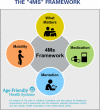Frailty as a dynamic process in a diverse cohort of older persons with dialysis-dependent CKD
- PMID: 37675341
- PMCID: PMC10479570
- DOI: 10.3389/fneph.2023.1031338
Frailty as a dynamic process in a diverse cohort of older persons with dialysis-dependent CKD
Abstract
This study examines frailty status evolution observed in a two-year follow-up of a cohort of older persons (age ≥65) with chronic kidney disease (CKD) undergoing maintenance hemodialysis (HD) treatment. Frailty, a geriatric syndrome that connotes a state of low physiologic reserve and vulnerability to stressors, is associated with increased risk for multiple adverse health outcomes in studies of persons with CKD as well as older persons in the general population. The Fried frailty index defines frailty as the presence of 3 or more of 5 indicators-recent unintentional weight loss, slowed gait speed, decreased muscle strength, self-reported exhaustion, and low physical activity. In the seminal work by Fried and colleagues, persons who were characterized by 1-2 of the Fried index criteria were termed "pre-frail" and considered at risk for subsequently becoming frail, potentially providing insight regarding intervention targets that might slow or prevent individuals' transition from pre-frail to frail status. Other less frequently studied types of transitions may also be informative, including "recovery or reversion" (improvement) by people whose longitudinal assessments indicate movement from frailty to prefrailty or robust, or from prefrailty to robust. These status changes are also a potential source of insights relevant for prevention or remediation of frailty, but research focusing on the various ways that individuals may transition between frailty states over time remains limited, and no previous research has examined varying patterns of frailty status evolution in an older cohort of persons with dialysis-dependent CKD. In a study cohort of dialysis-dependent older persons, we characterized patterns of frailty status evolution by age, sex, race/ethnicity, and treatment vintage; by longitudinal profiles of non-sedentary behavior; and by self-report indicators relevant for dimensions emphasized in the Age-Friendly 4Ms Health System (What Matters, Mobility, Mentation). Our study suggests that strategies to promote resiliency among older persons with dialysis-dependent CKD can be informed not only by frailty status transition that indicates improvement over time but also by older adults' maintenance of (stable) robust status over time, and we concur that inclusion of both frailty and resilience measures is needed in future longitudinal studies and clinical trials.
Keywords: 4MS; chronic kidney disease; frailty; hemodialysis; older persons; resilience.
Copyright © 2023 Kutner and Zhang.
Conflict of interest statement
The authors declare that the research was conducted in the absence of any commercial or financial relationships that could be construed as a potential conflict of interest.
Figures


Similar articles
-
The Burden of Frailty on Mood, Cognition, Quality of Life, and Level of Independence in Patients on Hemodialysis: Regina Hemodialysis Frailty Study.Can J Kidney Health Dis. 2020 May 2;7:2054358120917780. doi: 10.1177/2054358120917780. eCollection 2020. Can J Kidney Health Dis. 2020. PMID: 32426148 Free PMC article.
-
Frailty Assessment Tools in Chronic Kidney Disease: A Systematic Review and Meta-analysis.Kidney Med. 2025 Jan 4;7(3):100960. doi: 10.1016/j.xkme.2024.100960. eCollection 2025 Mar. Kidney Med. 2025. PMID: 39980935 Free PMC article.
-
Patterns and Predictors of Frailty Transitions in Older Men: The Osteoporotic Fractures in Men Study.J Am Geriatr Soc. 2017 Nov;65(11):2473-2479. doi: 10.1111/jgs.15003. Epub 2017 Sep 5. J Am Geriatr Soc. 2017. PMID: 28873220 Free PMC article.
-
Frailty phenotype and chronic kidney disease: a review of the literature.Int Urol Nephrol. 2015 Nov;47(11):1801-7. doi: 10.1007/s11255-015-1112-z. Epub 2015 Sep 28. Int Urol Nephrol. 2015. PMID: 26411428 Review.
-
Frailty and dialysis initiation.Semin Dial. 2013 Nov-Dec;26(6):690-6. doi: 10.1111/sdi.12126. Epub 2013 Sep 4. Semin Dial. 2013. PMID: 24004376 Free PMC article. Review.
Cited by
-
Longitudinal transitions in frailty and health-related quality of life investigated by a 5-year community study.Sci Rep. 2025 Apr 30;15(1):15162. doi: 10.1038/s41598-025-99843-7. Sci Rep. 2025. PMID: 40307486 Free PMC article.
-
Association between polypharmacy and 2-year outcomes among Chinese older inpatients: a multi-center cohort study.BMC Geriatr. 2024 Sep 9;24(1):748. doi: 10.1186/s12877-024-05340-3. BMC Geriatr. 2024. PMID: 39251936 Free PMC article.
References
LinkOut - more resources
Full Text Sources

